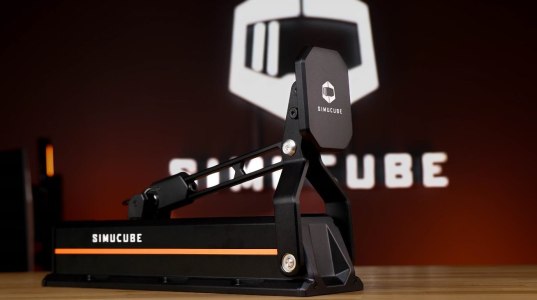Update (30. 07. 2013):

I made it shorter and I'm working on a different clamp. I will have new table so I have to rebuild it a bit. I also used "washers" from transparent film to eliminate accidental squeeking and don't have to use any grease now.

Old version now:

This is my sequential shifter I finished this week. It was an interesting project and I use it with Fanatec GT3 RS wheel.
You could say, by the look of it, it's another Frex Shifter+ clone. And you are right... Yes, I could buy Frex Shifter+, but wanted something longer and closer to my table.
I have various aluminium sheets to work with, so I didn't have to buy them. The clamping mechanism is made from a heatsink. Unfortunately, it's a bit soft and it bent a little when I tried it for the first time. Now I use it with anti slip pad and it works OK for now.. However, I'd like to replace the clamping mechanism with something better in the future.
I still have a minor issue with the central pivot that has bigger holes drilled in those big nuts that I use as bushings. I put there graphite vaseline (good stuff) because it was squeeking a bit after a while. I'll have to buy a drill with smaller diameter and make new bushings. It works good, although I sometimes feel how it moves a bit.
Gear knob is bought from eBay. Not very good but cheap. I'd like some Delrin hardbar and that isn't cheap, unfortunately...
I wanted to use just simple on-off-on switch as you can see on Frex shifter. I wasn't satisfied with it and it was too loud, so I bought two micro switches instead. The downside is, it allows "cheating" when shifting. At least, if you want to. The lever returns to the central position when you don't grip it too hard so it's acceptable. But you can still miss shift when shifting with this solution.
The lever is 28 cm long (from central pivot) and travels 2,5 to 4 cm. So you need to move it at least 2,5 cm for the switch to make a click. You don't feel it, but hear it a bit instead even through headphones. The lever isn't easy to push/pull but it's not hard either. It feels good even without any mechanical feedback or stopper.
I damaged a few bolts in the progress as I wanted to make some pivots. And bought quite a lot springs to work with. None of them worked for me because they were soft and I came across a real automotive parts, springs in repair kit for rear drum brakes for VW, Seat and Skoda. These worked well, fortunately, because I wanted to stop working on this project.
I had no idea if this project would work, so I'm satisfied with the result. And also addicted. It's in the perfect position when I reach for the lever.
Now, the "dark" side of any DIY project - the price. It cost me 70€ which is more than I'd planned. However, the real cost is probably about 50€, because you know how it is, you buy unnecessary bolts, nuts, springs, drills and so on...
Another Frex clone, but you can take it as an inspiration. I've seen some projects, yet none of them use springs in this configuration.
Some pics and a short video. Video from action possibly later.








Wiring (front side of ps/2 connector is drawn here!):

And this was WIP:


I made it shorter and I'm working on a different clamp. I will have new table so I have to rebuild it a bit. I also used "washers" from transparent film to eliminate accidental squeeking and don't have to use any grease now.

Old version now:

This is my sequential shifter I finished this week. It was an interesting project and I use it with Fanatec GT3 RS wheel.
You could say, by the look of it, it's another Frex Shifter+ clone. And you are right... Yes, I could buy Frex Shifter+, but wanted something longer and closer to my table.
I have various aluminium sheets to work with, so I didn't have to buy them. The clamping mechanism is made from a heatsink. Unfortunately, it's a bit soft and it bent a little when I tried it for the first time. Now I use it with anti slip pad and it works OK for now.. However, I'd like to replace the clamping mechanism with something better in the future.
I still have a minor issue with the central pivot that has bigger holes drilled in those big nuts that I use as bushings. I put there graphite vaseline (good stuff) because it was squeeking a bit after a while. I'll have to buy a drill with smaller diameter and make new bushings. It works good, although I sometimes feel how it moves a bit.
Gear knob is bought from eBay. Not very good but cheap. I'd like some Delrin hardbar and that isn't cheap, unfortunately...
I wanted to use just simple on-off-on switch as you can see on Frex shifter. I wasn't satisfied with it and it was too loud, so I bought two micro switches instead. The downside is, it allows "cheating" when shifting. At least, if you want to. The lever returns to the central position when you don't grip it too hard so it's acceptable. But you can still miss shift when shifting with this solution.
The lever is 28 cm long (from central pivot) and travels 2,5 to 4 cm. So you need to move it at least 2,5 cm for the switch to make a click. You don't feel it, but hear it a bit instead even through headphones. The lever isn't easy to push/pull but it's not hard either. It feels good even without any mechanical feedback or stopper.
I damaged a few bolts in the progress as I wanted to make some pivots. And bought quite a lot springs to work with. None of them worked for me because they were soft and I came across a real automotive parts, springs in repair kit for rear drum brakes for VW, Seat and Skoda. These worked well, fortunately, because I wanted to stop working on this project.
I had no idea if this project would work, so I'm satisfied with the result. And also addicted. It's in the perfect position when I reach for the lever.
Now, the "dark" side of any DIY project - the price. It cost me 70€ which is more than I'd planned. However, the real cost is probably about 50€, because you know how it is, you buy unnecessary bolts, nuts, springs, drills and so on...
Another Frex clone, but you can take it as an inspiration. I've seen some projects, yet none of them use springs in this configuration.
Some pics and a short video. Video from action possibly later.








Wiring (front side of ps/2 connector is drawn here!):

And this was WIP:











